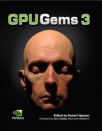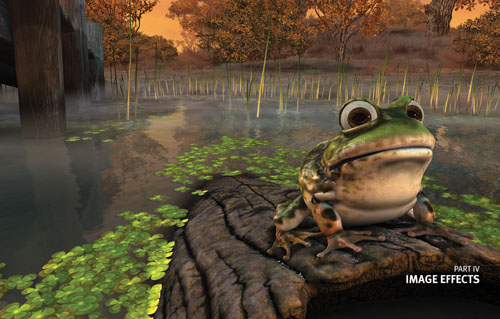
GPU Gems 3
GPU Gems 3 is now available for free online!
The CD content, including demos and content, is available on the web and for download.
You can also subscribe to our Developer News Feed to get notifications of new material on the site.
Part IV: Image Effects
In preparing this section of GPU Gems 3, I revisited the matching sections of the previous volumes. It's exciting to see that the ideas presented in our first two books have already become de rigeur throughout the game and entertainment industries. Standards like HDR and OpenEXR (GPU Gems) and techniques like high-quality GPU color transformations (GPU Gems 2) are already widely accepted and in use everywhere. Some of the informative chapters ahead, from my vantage point, look to be equally influential over the coming years. As of 2007, with more emphasis than ever on high-quality 2D and 3D imaging—not just in games but even on the basic desktop views of the newest operating systems—this is especially promising.
Alongside the rapid growth in GPU power over the past few years, we've seen surprising quality improvements and a drop in prices for large displays. Some gamers and other high-end computer users are already using resolutions as high as 2560x1600—on a single monitor—on a daily basis. Many are spreading their screen real estate even further by attaching additional monitors. Truly pocketable still cameras of 10 megapixels or higher are already common in discount stores, and consumer HD video can be seen at every neighborhood-league soccer game. The demand for great-looking ways to fill these newly available pixels—more than a 5x increase over the 1024x768 screens that are still expected by many games—helps drive new improvements and ideas in imaging.
Traditional TV and movie makers have been industrious in picking up on these new technologies, offering comprehensive broadcast content at HD sizes and seizing on the capabilities of interactive imaging to push the boundaries of their craft. Interactive computer imaging is forging ahead, not just in the new generations of special effects, but as a core part of the entire film and video production pipeline, providing greater interaction, higher productivity, and better, more sophisticated pictures. Even scientific visualizations and the interactive graphics of the evening TV weather report have surged ahead both in gloss and resolution, offering not just prettier numbers but more informative ones. This flood of new imagery is seen daily by every consumer, and in turn it drives their expectations ever higher.
For game makers, the new changes in resolution provide challenges in design. How can they make games (especially multiplayer games) that are approachable by players using not only the newest, high-performance computers but also older, low-capability computers—giving all players great experiences while still respecting the advancing trends in consumer choices and engaging the leading edge of what the new hardware permits? What strategies can game designers take so that their games look terrific today and also in the future?
Image effects provide a great way to layer new and increasingly sophisticated looks onto existing graphics frameworks. They can create images using vector-style graphics that will scale beautifully to any resolution, use 2D/3D-hybrid particle systems for environmental richness, and apply effects that can be tuned in complexity according to the capabilities of the player's computer and the demands of their display device. At a minimum, they can ensure that the experience of color is nuanced and true to the art department's vision.
Image effects, more than any other specialty, deal directly with human visual perception—whether the images are real-world pictures and videos, or completely synthetic inventions. The chapters in this part of the book address the elements of perception: issues of color, of perceived detail, and of the use of visual tools like motion blur and depth of field to enrich and direct the user's gaze and their game-playing experience.
These ideas are not theoretical—the chapters here all come from ideas being incorporated into real software for today's PCs, and tomorrow's.
Kevin Bjorke, NVIDIA Corporation
- Contributors
- Foreword
- Part I: Geometry
-
- Chapter 1. Generating Complex Procedural Terrains Using the GPU
- Chapter 2. Animated Crowd Rendering
- Chapter 3. DirectX 10 Blend Shapes: Breaking the Limits
- Chapter 4. Next-Generation SpeedTree Rendering
- Chapter 5. Generic Adaptive Mesh Refinement
- Chapter 6. GPU-Generated Procedural Wind Animations for Trees
- Chapter 7. Point-Based Visualization of Metaballs on a GPU
- Part II: Light and Shadows
-
- Chapter 8. Summed-Area Variance Shadow Maps
- Chapter 9. Interactive Cinematic Relighting with Global Illumination
- Chapter 10. Parallel-Split Shadow Maps on Programmable GPUs
- Chapter 11. Efficient and Robust Shadow Volumes Using Hierarchical Occlusion Culling and Geometry Shaders
- Chapter 12. High-Quality Ambient Occlusion
- Chapter 13. Volumetric Light Scattering as a Post-Process
- Part III: Rendering
-
- Chapter 14. Advanced Techniques for Realistic Real-Time Skin Rendering
- Chapter 15. Playable Universal Capture
- Chapter 16. Vegetation Procedural Animation and Shading in Crysis
- Chapter 17. Robust Multiple Specular Reflections and Refractions
- Chapter 18. Relaxed Cone Stepping for Relief Mapping
- Chapter 19. Deferred Shading in Tabula Rasa
- Chapter 20. GPU-Based Importance Sampling
- Part IV: Image Effects
-
- Chapter 21. True Impostors
- Chapter 22. Baking Normal Maps on the GPU
- Chapter 23. High-Speed, Off-Screen Particles
- Chapter 24. The Importance of Being Linear
- Chapter 25. Rendering Vector Art on the GPU
- Chapter 26. Object Detection by Color: Using the GPU for Real-Time Video Image Processing
- Chapter 27. Motion Blur as a Post-Processing Effect
- Chapter 28. Practical Post-Process Depth of Field
- Part V: Physics Simulation
-
- Chapter 29. Real-Time Rigid Body Simulation on GPUs
- Chapter 30. Real-Time Simulation and Rendering of 3D Fluids
- Chapter 31. Fast N-Body Simulation with CUDA
- Chapter 32. Broad-Phase Collision Detection with CUDA
- Chapter 33. LCP Algorithms for Collision Detection Using CUDA
- Chapter 34. Signed Distance Fields Using Single-Pass GPU Scan Conversion of Tetrahedra
- Chapter 35. Fast Virus Signature Matching on the GPU
- Part VI: GPU Computing
-
- Chapter 36. AES Encryption and Decryption on the GPU
- Chapter 37. Efficient Random Number Generation and Application Using CUDA
- Chapter 38. Imaging Earth's Subsurface Using CUDA
- Chapter 39. Parallel Prefix Sum (Scan) with CUDA
- Chapter 40. Incremental Computation of the Gaussian
- Chapter 41. Using the Geometry Shader for Compact and Variable-Length GPU Feedback
- Preface
